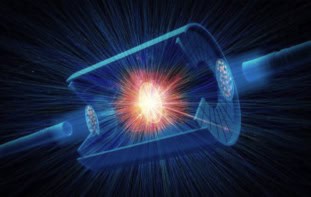Particle physicists in the US have gained new insights into what happens when a high-energy photon scatters inelastically off a proton. According to perturbative quantum chromodynamics, the momentum lost by the photon should be shared between all three of the proton's quarks via the exchange of two gluons. However, a new experiment at the Jefferson Laboratory in Virginia suggests that this Compton-scattering process is better described by an alternative "handbag" model, in which one quark collides with the photon, sharing the momentum with its neighbours via an undetermined number of gluons (Phys. Rev. Lett. 98 152001).
Protons and other hadrons are made of three quarks held together by gluons, which mediate the “strong” interactions between the quarks. While all of this is elegantly described by quantum chromodynamics (QCD), the strong interaction confines the quarks inside hadrons, which makes it impossible to study the properties of individual quarks. Moreover, the equations of QCD are eye-wateringly difficult to solve and physicists instead have to use approximations to QCD to predict the properties of protons and other hadrons.
If a proton is involved in a high-energy collision, the behaviour of its constituent quarks can, however, be approximated using perturbative QCD (pQCD), which assumes that the three quarks behave essentially like weakly interacting particles. This technique was used in the early 1980s to analyze cross-section data from a Compton scattering experiment carried out at Cornell University. A cross-section is a measure of the likelihood that a specific scattering event will occur. The apparent success of this analysis had led physicists to conclude that the pQCD approximation was valid for Compton scattering at energies of a few GeV.
However, in the intervening years some researchers suspected that the scattering was better defined by another approximation to QCD called the handbag model. In the absence of any new experimental data, however, this question had remained unresolved.
But now physicists from the Hall A collaboration at the Jefferson Lab accelerator have performed a new set of more accurate Compton scattering experiments that provide strong evidence that, at low energies of a few GeV at least, the handbag approach is the better of the two. In particular, the relationship between the cross-sections and the momentum of the collisions was much better described by the handbag model than by pQCD.
Jefferson Lab’s Kees de Jager told Physics Web that while pQCD remains valid at higher energies, “the handbag dominates in the few-GeV range”.



